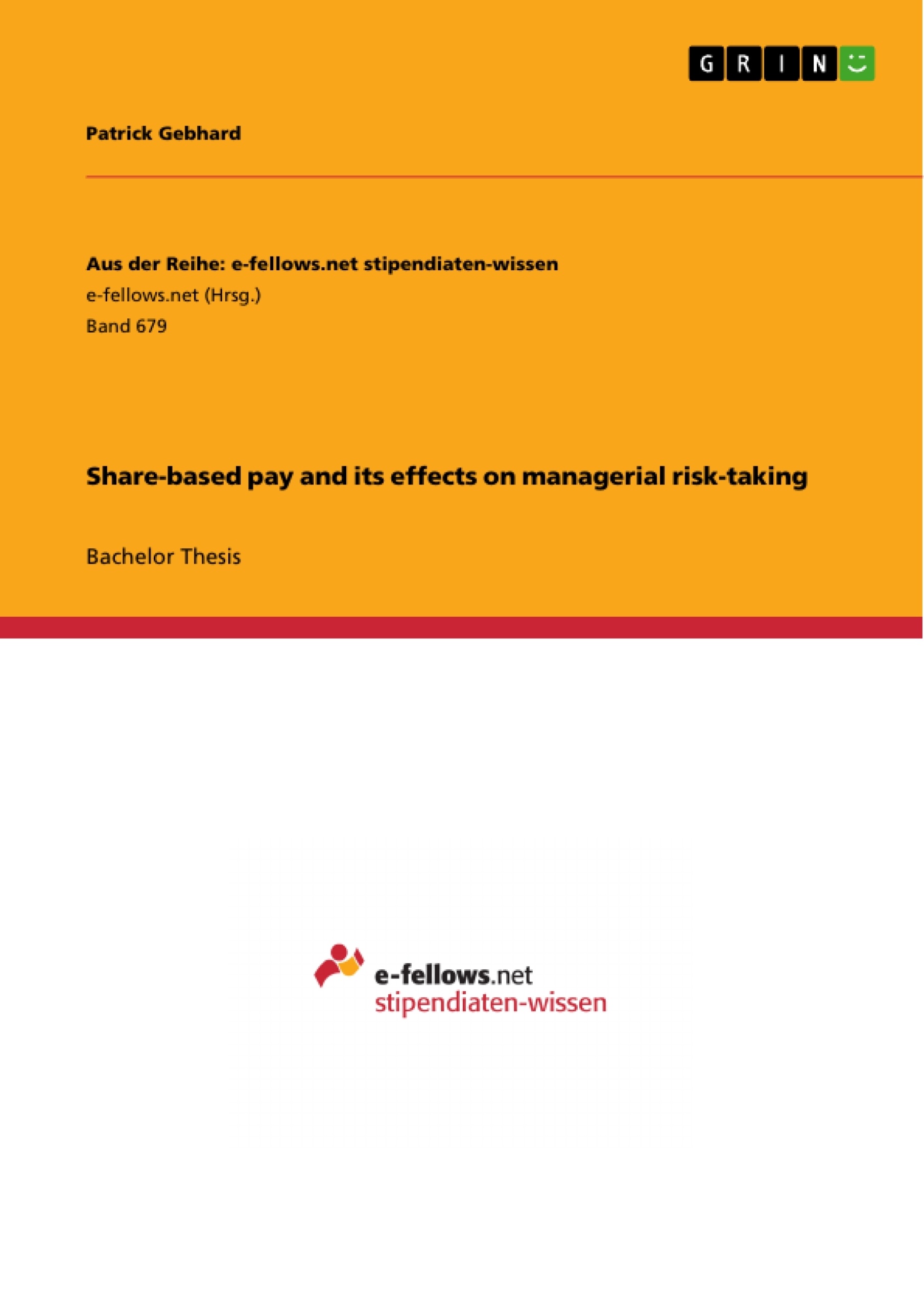Blick ins Buch

Share-based pay and its effects on managerial risk-taking
Bachelorarbeit, 2013
53 Seiten
Leseprobe
Inhaltsverzeichnis (Table of Contents)
- The growing use of stock-based compensation
- The diverging risk preferences of principal and agent
- Overcoming managerial risk aversion
- The risk premium on share-based pay
- The influence of the exercise price, degree of diversification and the risk aversion parameter on the risk premium of the manager
- The importance to distinguish between firm-specific and systematic risk when the market portfolio can be traded
- Implications for the use of share-based pay and research on the effects of share-based pay
- Theoretical predictions on the risk incentives provided by share-based pay
- The effects of managerial risk aversion and compensation design on risk incentives provided by share-based pay
- The incentives provided by share-based pay regarding total risk
- The effects provided by share-based pay to change systematic risk, firm-specific risk and the correlation between company returns and market returns
- Empirical findings on the relationship between share-based pay and company risk
- Estimating the sensitivities to stock price and stock volatility of a manager's portfolio with the “one-year” approach
- The joint determination of firm risk characteristics and share-based pay
- The incentives provided by vega and delta to change the components of risk
- Descriptive analyses of the pay-performance sensitivities of German DAX and MDAX executives
- Sample description
- Calculation of the pay-performance sensitivity
- The alignment of DAX and MDAX board members
- Summary of results
Zielsetzung und Themenschwerpunkte (Objectives and Key Themes)
This thesis aims to examine the effects of share-based pay on managerial risk-taking. The work first describes the relationship between managers and shareholders as predicted by agency theory, thus providing motivation for the use of share-based pay. It then explores the influence of manager-specific attributes and compensation design on the risk premium and risk incentives. The thesis presents and discusses both theoretical and empirical research findings to gain insights into the determinants and effects of stock-based compensation. Finally, the thesis analyzes the pay-performance sensitivities of the stock and option portfolios of board members in the German DAX and MDAX during the period from 2006 to 2010. Key themes covered in the thesis include:- Agency theory and the relationship between managers and shareholders
- Managerial risk aversion and the effects of share-based pay
- The influence of compensation design on risk incentives
- Empirical analysis of pay-performance sensitivities in German companies
- The role of stock-based compensation in mitigating agency problems
Zusammenfassung der Kapitel (Chapter Summaries)
The first chapter discusses the growing use of stock-based compensation, focusing on the diverging risk preferences of principal and agent and the challenges in overcoming managerial risk aversion. Chapter 2 analyzes the risk premium on share-based pay, examining the influence of the exercise price, diversification, and risk aversion on the risk premium. It also emphasizes the importance of distinguishing between firm-specific and systematic risk. Chapter 3 explores the theoretical predictions on the risk incentives provided by share-based pay. It examines the effects of managerial risk aversion and compensation design on risk incentives and analyzes the impact of share-based pay on total risk, systematic risk, firm-specific risk, and the correlation between company returns and market returns. Chapter 4 presents empirical findings on the relationship between share-based pay and company risk. It discusses methods for estimating sensitivities to stock price and stock volatility, examines the joint determination of firm risk characteristics and share-based pay, and analyzes the incentives provided by vega and delta to change components of risk. Chapter 5 analyzes the pay-performance sensitivities of German DAX and MDAX executives. It provides a sample description, details the calculation of the pay-performance sensitivity, and explores the alignment of board members within these indices.Schlüsselwörter (Keywords)
The thesis focuses on key concepts such as agency theory, risk aversion, share-based pay, stock-based compensation, risk incentives, risk premium, pay-performance sensitivities, and firm-specific risk. It analyzes the effects of share-based pay on managerial risk-taking, particularly in the German context, and offers insights into the relationship between managerial compensation and corporate risk.
Ende der Leseprobe aus 53 Seiten
- nach oben
Details
- Titel
- Share-based pay and its effects on managerial risk-taking
- Hochschule
- Technische Universität München
- Autor
- Patrick Gebhard (Autor:in)
- Erscheinungsjahr
- 2013
- Seiten
- 53
- Katalognummer
- V211464
- ISBN (eBook)
- 9783656395614
- ISBN (Buch)
- 9783656396291
- Dateigröße
- 901 KB
- Sprache
- Englisch
- Schlagworte
- share-based pay managerial risk-taking manager shareholders agency theory compensation risk premium risk incentives stock-based compensation pay-performance stock option portfolio board members DAX MDAX
- Produktsicherheit
- GRIN Publishing GmbH
- Preis (Ebook)
- US$ 19,99
- Preis (Book)
- US$ 29,99
- Arbeit zitieren
- Patrick Gebhard (Autor:in), 2013, Share-based pay and its effects on managerial risk-taking, München, Page::Imprint:: GRINVerlagOHG, https://www.diplomarbeiten24.de/document/211464
Allgemein
Autoren
- Autor werden
- Ihre Optionen
- Vertriebskanäle
- Premium Services
- Autorenprofil
- Textarten und Formate
- Services für Verlage, Hochschulen, Unternehmen
Premium Services
FAQ
Marketing
Dissertationen
Leser & Käufer
Zahlungsmethoden

Copyright
- © GRIN Publishing GmbH.
- Alle Inhalte urheberrechtlich geschützt. Kopieren und verbreiten untersagt.
- info@grin.com
- AGB
- Open Publishing
Über GRIN
Der GRIN Verlag hat sich seit 1998 auf die Veröffentlichung akademischer eBooks und Bücher spezialisiert. Der GRIN Verlag steht damit als erstes Unternehmen für User Generated Quality Content. Die Verlagsseiten GRIN.com, Hausarbeiten.de und Diplomarbeiten24 bieten für Hochschullehrer, Absolventen und Studenten die ideale Plattform, wissenschaftliche Texte wie Hausarbeiten, Referate, Bachelorarbeiten, Masterarbeiten, Diplomarbeiten, Dissertationen und wissenschaftliche Aufsätze einem breiten Publikum zu präsentieren.
Kostenfreie Veröffentlichung: Hausarbeit, Bachelorarbeit, Diplomarbeit, Dissertation, Masterarbeit, Interpretation oder Referat jetzt veröffentlichen!
- GRIN Verlag GmbH
-
- Nymphenburger Str. 86
- 80636
- Munich, Deutschland
- +49 89-550559-0
- +49 89-550559-10
- info@grin.com
-









